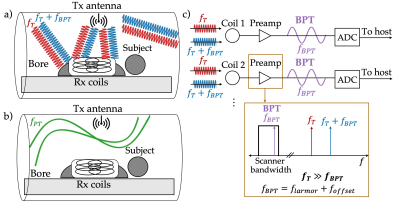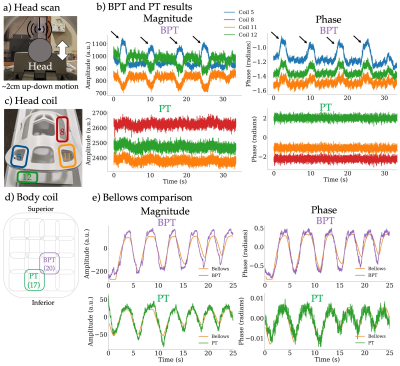Suma Anand1 and Michael Lustig1
1Electrical Engineering and Computer Sciences, University of California, Berkeley, Berkeley, CA, United States
1Electrical Engineering and Computer Sciences, University of California, Berkeley, Berkeley, CA, United States
Our motion sensing Beat Pilot Tone (BPT) requires no on-subject hardware and induces a beat frequency in the receiver via two tones (2.4GHz, 2.528GHz). BPT obtains improved sensitivity (20x) to motion compared to PT and does not impact image SNR.

Figure 1: A schematic illustration of (a) Beat Pilot Tone (BPT) vs. (b) Pilot Tone (PT) acquisitions. PT has a 2.347m wavelength ($$$f_{PT} = 127.8MHz$$$), while BPT has a 12.5cm wavelength ($$$ f_T = 2.4GHz $$$); thus, there is much more interaction between BPT and the cm-scale motion of the body. c) BPT uses two frequencies, $$$f_T$$$ and $$$f_T+f_{BPT}$$$, where $$$f_{BPT}=f_{larmor} + f_{offset}$$$ (e.g., $$$f_{offset} = 100kHz$$$). A signal with a beat frequency $$$f_{BPT}$$$ is mixed in the coil preamplifier due to intermodulation; this signal is the BPT.

Figure 4: a) A volunteer was asked to move their head up and down during the scan, a motion in the range of 2cm. b) BPT from the 3 most modulated coils are compared to the PT, with the coil arrangement in c). The arrows show up-down motion, which is clearly visible in BPT, but barely so in PT. d) The two most modulated body coils (17 and 20) for the abdominal scan. e) The BPT and PT magnitudes and phases were filtered with a moving average and scaled to match the bellows signal, which they match closely.
